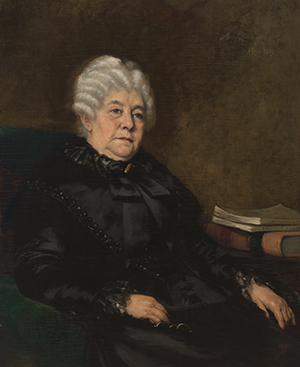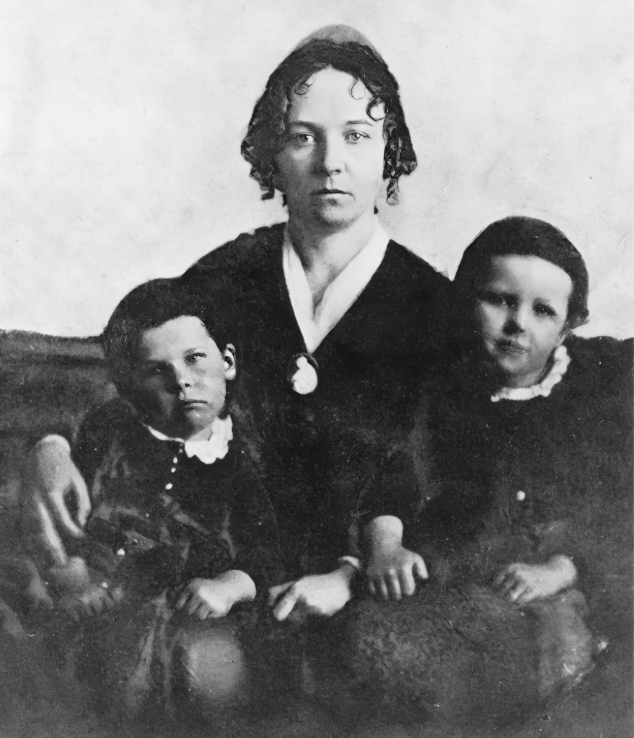Elizabeth Cady Stanton: Founding Philosopher of American Women's Rights
by Lori D. Ginzberg
 Elizabeth Cady Stanton (1815–1902) knew that history was powerful and, therefore, dangerous. When, after decades of advocating for women’s rights, she and her friends Susan B. Anthony and Matilda Joslyn Gage sat down to gather the primary sources of their movement, they considered the project “an arsenal of facts” that would in itself further “the most important demand of the century.”[1] At the same time, these lifelong activists exercised their own power in shaping history’s view of them, narrating a story of their movement’s origins, leadership, and goals that has remained largely intact. But if history is dangerous, as Stanton well understood, it is also complicated. Elizabeth Cady Stanton’s life and thought offer a perfect example of that complexity.
Elizabeth Cady Stanton (1815–1902) knew that history was powerful and, therefore, dangerous. When, after decades of advocating for women’s rights, she and her friends Susan B. Anthony and Matilda Joslyn Gage sat down to gather the primary sources of their movement, they considered the project “an arsenal of facts” that would in itself further “the most important demand of the century.”[1] At the same time, these lifelong activists exercised their own power in shaping history’s view of them, narrating a story of their movement’s origins, leadership, and goals that has remained largely intact. But if history is dangerous, as Stanton well understood, it is also complicated. Elizabeth Cady Stanton’s life and thought offer a perfect example of that complexity.
Elizabeth Cady Stanton was the founding philosopher of the US movement for women’s rights. Her influence is most evident when we consider how completely we accept as givens her bold and outrageous demands: for women’s right to own property, to acquire an education, to exercise a vote, to speak out, to get a divorce—the very things Stanton was referring to when she wrote, “This sounds like a very radical proposition now, but be sure that some day in the future Americans will ask how these things could ever have been done otherwise.”[2] Her own life provided both the iconic story and the necessary passion for making demands that now seem inevitable. Born in 1815 in Johnstown, New York, to Daniel and Margaret Livingston Cady, Elizabeth Cady grew up a child of privilege. Her father, who became a judge, was wealthy (he owned several enslaved people and a lot of land), well-connected, and deeply conservative. This was a time when a married woman, “covered” by her husband’s legal identity, could not own or inherit property; when girls could not pursue higher education; when even unmarried and widowed women who owned property and paid taxes could not vote; and when hardly anyone imagined that their daughters and sisters might aspire to an identity beyond that of wife and mother. Stanton often told of her experience as a boisterous and rebellious little girl, eleven years old, whose only living brother had just died. Distraught, she crawled into her father’s lap, seeking to give and receive comfort. But her father put his arm around her and sighed, “Oh, my daughter, I wish you were a boy!” Such insults continued. When the boys she had surpassed at the local school left for Union College, the young Elizabeth’s “vexation and mortification knew no bounds.”[3]
Stanton’s real education would take place in the antislavery movement, where she met, married, and moved among leading abolitionists. Even among these brave and broadminded orators and activists, she stood out for her focus on the wrongs women faced from church, state, and society. As early as 1840, when the newly married Elizabeth Cady Stanton traveled with her husband Henry to London for the World’s Antislavery Convention, the abolitionist leader William Lloyd Garrison reported that the young Mrs. Stanton “goes for woman’s rights with all her soul.”[4] She would turn her outrage and indignation into a lifelong commitment to describe, confront, and change the many restrictions—educational, legal, religious, and political—that shaped women’s lives. She belongs, by any measure, in the pantheon of people who shaped American democracy itself.
 Ideas and movements do not emerge in a vacuum. Certainly Stanton believed herself to be the very cutting edge of American radicalism, the person whose “long-accumulating discontent” had launched a movement.[5] Indeed, most textbooks describe the 1848 convention in Seneca Falls, New York, which Stanton, by then the mother of three young boys, and a few friends called the origin of American feminism. But no one who attended that convention, or the Rochester one two weeks later, was hearing about women’s rights for the first time. These people were abolitionists, part of the tiny community of antislavery activists who most White Americans, North and South, considered the lunatic fringe. They were used to demanding things that other folks declared not just wrong or bad, but unthinkable. Adding women’s rights to their inflammatory rhetoric about ending slavery and racism just proved how very dangerous they were.
Ideas and movements do not emerge in a vacuum. Certainly Stanton believed herself to be the very cutting edge of American radicalism, the person whose “long-accumulating discontent” had launched a movement.[5] Indeed, most textbooks describe the 1848 convention in Seneca Falls, New York, which Stanton, by then the mother of three young boys, and a few friends called the origin of American feminism. But no one who attended that convention, or the Rochester one two weeks later, was hearing about women’s rights for the first time. These people were abolitionists, part of the tiny community of antislavery activists who most White Americans, North and South, considered the lunatic fringe. They were used to demanding things that other folks declared not just wrong or bad, but unthinkable. Adding women’s rights to their inflammatory rhetoric about ending slavery and racism just proved how very dangerous they were.
Still, while the women and men who gathered at Seneca Falls largely agreed that women should be treated as individuals with rights, the Seneca Falls Declaration of Sentiments was extraordinary, a foundational text in American democratic ideals. Its language was impossible to ignore. “We hold these truths to be self-evident,” Stanton read aloud, “that all men and women are created equal.” She then proceeded to list numerous “repeated injuries and usurpations on the part of man toward woman”: the laws of marriage, restrictions against women entering the professions, religious teachings that silenced them, social norms that created a double standard of morality, and a society that sought to “destroy her confidence in her own powers.” By adopting the language of the nation’s most sacred text, Stanton reminded Americans that their Revolution had left unfinished business, that the “pursuit of happiness” itself had been denied them.[6]
It is a little hard to imagine how terrifying all this talk about women as independent, rights-bearing citizens was. It left its listeners—supporters as well as appalled opponents—breathless. Some newspaper editors could only sputter incoherently with outrage. Stanton’s words remind us of the radical potential of individual rights, including but not only the right to vote. Stanton was brilliant at expanding these fundamentally liberal views of women’s exclusion from American democracy to a radical critique of religion, of marriage, and of women’s sexual subordination to men. (I have tried for years to convince students that these ideas were unsettling and scary. My “teaching trick” has been to pose a serious demand that children be given the vote and watch them debate the issue. They inevitably echo nearly every charge against women voting that nineteenth-century opponents cooked up.)
But Stanton’s idea of women’s rights as essentially individual and her refusal to acknowledge a more complicated—what Black feminist scholars call intersectional—understanding of her own place and privilege also shape her legacy. Although she insisted that her analysis included, and benefitted, all women, she failed to reflect on how much her particular demands emerged from her own experience. For all her intellectual courage, when faced with opposition to her own priorities Stanton made comments so racist that they can leave us speechless; they exposed assumptions about whose rights mattered most that were pervasive and longstanding.
 Stanton’s implicit elitism was there from the beginning. Among the outrages listed at Seneca Falls was that women were denied rights “which are given to the most ignorant and degraded men—both natives and foreigners.” These views persisted, as when she came to support restricting the vote only to literate Americans. But her outrage at the exclusion of women like her (the “[White] daughters of Jefferson, Hancock and Adams,” she sputtered, “obliged to bow to the laws made by negroes and foreigners”)[7] came to a head during Reconstruction, when abolitionists disagreed among themselves over whether to support the Fifteenth Amendment to the US Constitution, which would protect suffrage on the basis of race and thus give Black men, but not women, the vote. Stanton and her friend Susan B. Anthony, feeling betrayed by those friends and allies who believed that recently emancipated Black communities needed the vote more urgently, stood firmly, and furiously, by “universal” suffrage that included the vote for women.
Stanton’s implicit elitism was there from the beginning. Among the outrages listed at Seneca Falls was that women were denied rights “which are given to the most ignorant and degraded men—both natives and foreigners.” These views persisted, as when she came to support restricting the vote only to literate Americans. But her outrage at the exclusion of women like her (the “[White] daughters of Jefferson, Hancock and Adams,” she sputtered, “obliged to bow to the laws made by negroes and foreigners”)[7] came to a head during Reconstruction, when abolitionists disagreed among themselves over whether to support the Fifteenth Amendment to the US Constitution, which would protect suffrage on the basis of race and thus give Black men, but not women, the vote. Stanton and her friend Susan B. Anthony, feeling betrayed by those friends and allies who believed that recently emancipated Black communities needed the vote more urgently, stood firmly, and furiously, by “universal” suffrage that included the vote for women.
Stanton could have stuck to the lofty rhetoric of universal justice, to her insistence that voting was a right of citizens, not a privilege of those deemed worthy. Instead, fired up with indignation, she let loose some extraordinarily racist remarks to the effect that educated White women were more “fit” to vote than recently emancipated African American men. Protected by the Thirteenth Amendment, Stanton announced, “the black man is declared free,” but “as the celestial gate to civil rights is slowly moving on its hinges, it becomes a serious question whether [the ‘representative women of the nation’] had better stand aside and see ‘Sambo’ walk into the kingdom first.” As for Black women, “it is better,” Stanton declared, “to be the slave of an educated white man, than of a degraded, ignorant black one.”[8] For Stanton, African Americans’ emancipation, and the terrible racial violence that they faced in the South, was no longer the central crisis for her generation and her country; rather, the “negro question” was over: “[T]he curtain has fallen on the last act,” she wrote in 1868, “the lights are extinguished, and the audience gone to their homes.”[9]
These differences among activists, from which emerged two suffrage organizations, shaped strategies and tactics in the movement for woman suffrage for decades to come. Stanton remained convinced of the rightness, and the radicalism, of her own views even as the movement itself came to focus more narrowly on gaining the vote. (She would have been distressed by textbooks and teachers who associate her only with the cause of woman suffrage.) Over and over, she was positive that she had found what she called the “one true cause” of women’s subordination, whether it was “in man’s idea of his sexual rights”[10] or the oppression of women in biblical texts, and she could hardly contain her glee at her own cleverness. But however much she disdained the nuts and bolts lobbying that would eventually make woman suffrage the law of the land, Stanton’s impact on how future generations framed women’s rights—as the largely individual concerns of White, middle-class, Protestant married women like herself—has been immense.
Elizabeth Cady Stanton was a complex person, infuriating and fascinating; she was brilliant, charming, and charismatic, as well as self-righteous, intimidating, and astonishingly self-confident. The mother of seven children, an advocate of liberalized divorce laws, and a skeptic about religion, she comes across through her eighty-seven years as larger than life, a woman driven by her commitment to rouse herself, and everyone else, to rethink and remake women’s status in politics, law, religion, and marriage. “My feeling,” Stanton declared at seventy-five, “is to tone up rather than down.”[11] Teachers and students, indeed all Americans, should surely applaud her willingness to describe, analyze, and challenge a vast range of injustices, while at the same time recognizing that her limitations and blindnesses continue to influence how we think about rights and justice themselves.
Recommended Readings
DuBois, Ellen Carol. Feminism and Suffrage: The Emergence of an Independent Women’s Movement in America, 1848–1869. Ithaca: Cornell University Press, 1978.
Ginzberg, Lori D. Untidy Origins: A Story of Woman’s Rights in Antebellum New York. Chapel Hill: University of North Carolina Press, 2005.
Gordon, Ann D. The Selected Papers of Elizabeth Cady Stanton and Susan B. Anthony. New Brunswick, NJ: Rutgers University Press, 1997–2006), vols. 1–4.
Kern, Kathi. Mrs. Stanton’s Bible. Ithaca: Cornell University Press, 2001.
Tetrault, Lisa. The Myth of Seneca Falls: Memory and the Women’s Suffrage Movement, 1848–1898. Chapel Hill: University of North Carolina Press, 2014.
Wellman, Judith. The Road to Seneca Falls: Elizabeth Cady Stanton and the First Woman’s Rights Convention. Urbana: University of Illinois Press, 2004.
Lori D. Ginzberg is professor emeritus of history and women’s, gender and sexuality studies at Penn State University. She is the author of several books, including Elizabeth Cady Stanton: An American Life (Farrar, Straus and Giroux, 2009) and Tangled Journeys: One Family’s Story and the Making of American History (University of North Carolina Press, 2024).
[1] Elizabeth Cady Stanton, Susan B. Anthony, and Matilda Joslyn Gage, eds. History of Woman Suffrage, vol. 1: 1848–1861 (Rochester, New York: Fowler & Wells, 1889), p. 7.
[2] Elizabeth Cady Stanton to Martha C. Wright, February 10, 1861, in Elizabeth Cady Stanton as Revealed in Her Letters, Diary, and Reminiscences, vol. 2, ed. Theodore Stanton and Harriet Stanton Blatch (New York and London: Harper & Brothers Publishers, 1922), p. 87.
[3] Elizabeth Cady Stanton, Eighty Years and More: Reminiscences, 1815–1897 (New York: Schocken Books, 1971), pp. 20, 33.
[4] William Lloyd Garrison to Helen Garrison, June 29, 1840, quoted in Clare Taylor, British and American Abolitionists. An Episode in Transatlantic Understanding (Edinburgh: Edinburgh University Press, 1974), p. 93.
[5] Stanton, Eighty Years and More, p. 148.
[6] The Declaration of Sentiments adopted at Seneca Falls is widely reprinted. See Stanton, Anthony, and Gage, History of Woman Suffrage, vol. 1, pp. 70–73.
[7] Elizabeth Cady Stanton to Frank P. Blair, October 1, 1868, Elizabeth Cady Stanton Papers, Library of Congress.
[8] Stanton to Editor, National Anti-Slavery Standard, in Ann D. Gordon, ed., The Selected Papers of Elizabeth Cady Stanton & Susan B. Anthony, vol. 1 (New Brunswick, NJ: Rutgers University Press, 1998), pp. 564–565.
[9] Revolution 1:4, January 29, 1868, p. 50.
[10] Elizabeth Cady Stanton to Susan B. Anthony, June 14, 1860, in Elizabeth Cady Stanton as Revealed in Her Letters, Diary, and Reminiscences, vol. 2, ed. Theodore Stanton and Harriet Stanton Blatch (New York and London: Harper & Brothers Publishers, 1922), pp. 82–83.
[11] Elizabeth Cady Stanton to Clara Colby, June 16, [1890], The Papers of Elizabeth Cady Stanton and Susan B. Anthony, eds. Patricia G. Holland and Ann D. Gordon (Wilmington, Delaware: Scholarly Resources, 1992), microfilm reel 28.









































































